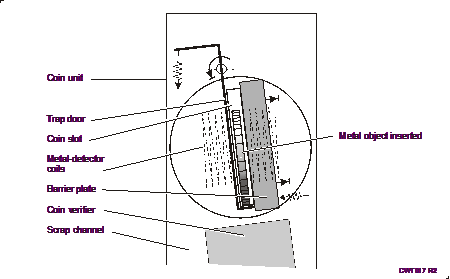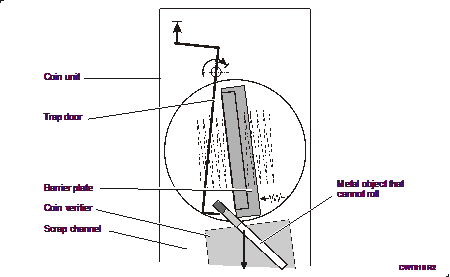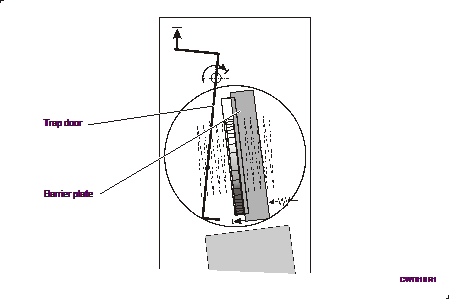
CWT Compact S2 Installation & Maintenance Manual
The function of the anti-pin module is to prevent external manipulation of the coin system. The figures below illustrate the function principles of the anti-pin module. The mechanism is seen from above.
The anti-pin module has a pair of metal-detector coils just inside the coin slot opening. A bit further in there is a barrier plate that usually covers the coin slot. The barrier plate is pulled into closed position by a tension spring.
A slightly inclined trap door, operated by a solenoid plunger, is held in opened (clock-wise) position by a permanent magnet inside the solenoid across which no voltage is currently applied (the above figure shows the trap door in its closed position).
The figure below illustrates the mechanism in idle mode before any metal object is detected in the coin slot. The barrier plate is kept closed by a compression spring and the trap door is in the open position.

Figure 3, Anti pin in idle mode. The barrier plate covers the coin slot opening and the trap door rests in open position.
When a metal object is detected by the detector coils, a voltage is temporarily applied across a separate coil in the solenoid which generates a magnetic field that repulses the field of the permanent magnet. The trap door now rotates anti-clockwise pulled by a tension spring mounted on the solenoid plunger. The trap door also forces the barrier plate to the right to allow the metal object to be fully inserted. See figure below.

Figure 4, Barrier plate, and thus the antipin module, opens for metal objects.
The almost vertical trap door has a perpendicular shelf at its lower edge. This shelf slopes downward and rearward toward the coin verifier. A round metal object will roll along the shelf and fall into the coin verifier. A metal object that cannot roll will fall into the scrap channel as the trap door is swung clock-wise by the solenoid after a pre-set time delay.

Figure 5, Non-valid metal objects are scrapped.
The permanent magnet in the solenoid module will keep the trap door in open position and thus no voltage needs to be applied to the solenoid continually which reduces the power consumption.
As the trap door opens, the compression spring will close the coin slot by pushing the barrier plate to the left.

Figure 6, Metal object stuck in the coin slot.
If an object, or part of an object, remains in the coin slot opening as shown in the figure above, the barrier plate will stop against this object but will close as soon as the object is removed.
| Important: The function of the coin system may be interrupted if the terminal leans too much in any direction. |
If an object, or part of an object, is inserted and prevents the trap door from closing, this will be detected. The coin system will try to remove the object, if it doesn’t succeed the terminal will send an alarm to WebOffice.
